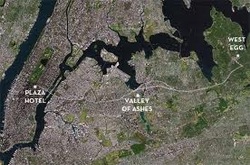
Read Chapter two before responding.
The copious amount of ash produced by coal-burning furnaces throughout the city had to go somewhere, and one dumping ground was in Corona, Queens, or as Fitzgerald refers, the valley of ashes:
“This is the valley of ashes, a fantastic farm where ashes grow like wheat into ridges and hills and grotesque gardens; where ashes take the form of houses and chimneys and rising smoke and, finally, with a transcendent effort, of men who move dimly and already crumbling through the powdery air. Occasionally a line of gray cars crawls . . . immediately the ash-gray men swarm up with leaden spades . . . which screens their obscure operations from your sight” (23).
The valley of ashes is everything the Eggs appear not to be—appear being the key word. One critic says that the valley of ashes symbolizes the moral decay which is veiled by the wealthy appearance of the Eggs; beneath this outward appearance (pretention) is the same ugliness that runs through the valley of ashes.
Do you agree or disagree with this based on what we’ve read thus far? Think about the description of both the Eggs and the valley of ashes. Support your response with specific encounters, interactions, and inferences.
Next, think about your own lives and experiences. Do outward appearances always project accurate inner character? Think about social class (including the poorest of characters presented in the valley of ashes). Can one truly be above someone? Or are we all rather grounded to some mutual root? How does this relate to the story and how would this affect the American dream?
Think about this before responding—there is much more going on here than what appears (just like the Eggs!). A thorough response is assured the entire twenty points—so make it thorough!
The copious amount of ash produced by coal-burning furnaces throughout the city had to go somewhere, and one dumping ground was in Corona, Queens, or as Fitzgerald refers, the valley of ashes:
“This is the valley of ashes, a fantastic farm where ashes grow like wheat into ridges and hills and grotesque gardens; where ashes take the form of houses and chimneys and rising smoke and, finally, with a transcendent effort, of men who move dimly and already crumbling through the powdery air. Occasionally a line of gray cars crawls . . . immediately the ash-gray men swarm up with leaden spades . . . which screens their obscure operations from your sight” (23).
The valley of ashes is everything the Eggs appear not to be—appear being the key word. One critic says that the valley of ashes symbolizes the moral decay which is veiled by the wealthy appearance of the Eggs; beneath this outward appearance (pretention) is the same ugliness that runs through the valley of ashes.
Do you agree or disagree with this based on what we’ve read thus far? Think about the description of both the Eggs and the valley of ashes. Support your response with specific encounters, interactions, and inferences.
Next, think about your own lives and experiences. Do outward appearances always project accurate inner character? Think about social class (including the poorest of characters presented in the valley of ashes). Can one truly be above someone? Or are we all rather grounded to some mutual root? How does this relate to the story and how would this affect the American dream?
Think about this before responding—there is much more going on here than what appears (just like the Eggs!). A thorough response is assured the entire twenty points—so make it thorough!
 RSS Feed
RSS Feed